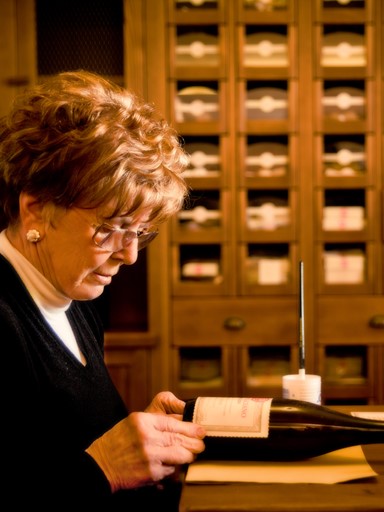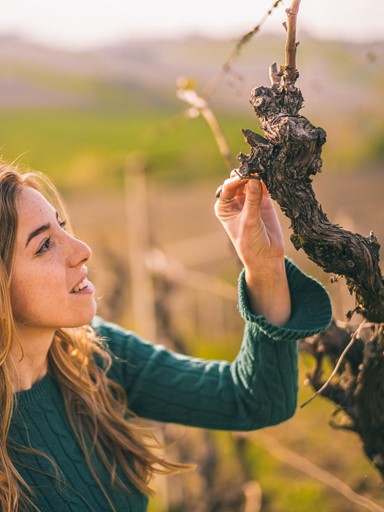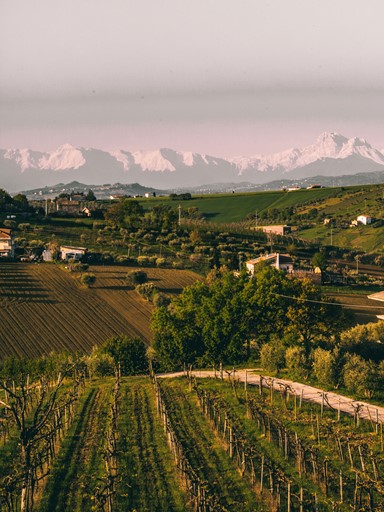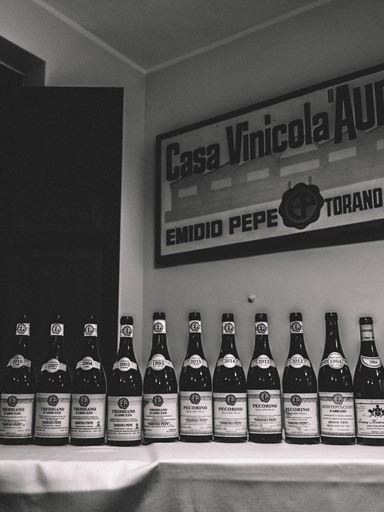
In Vino Vita
Emidio Pepe, Abruzzo, Italy
High scoring, extremely limited, new 2017 and 2018 vintage release direct from the Emidio Pepe cellar…
For a man who started with one hectare of Montepulciano vines, producing just 3,000 bottles whilst driving all over Europe with a fully laden Alfa Romeo, stopping at Italian restaurants to sell his wine, Emidio Pepe has today grown to 17 hectares, 80,000 bottles and a bottle price that reflects the highest quality wine, positioning it as one of Italy's finest.
It could be argued that Emidio Pepe is responsible for waking up the world to the endless potential of the Abruzzo region, so clearly demonstrated over his lifetime. With 56 vintages under his belt, Pepe has stood undeterred by his beliefs that Montepulciano d'Abruzzo was capable of becoming an age-worthy fine wine. For the lucky wine drinkers and collectors amongst us, how fortunate we are that he did! Although very little has changed since 1964, biodynamic certification was granted in 2006 - led by his daughter Sofia - who now oversees the winemaking at the estate. Prior to this, the estate was run completely organically, "never has selected yeast entered our cellar - this is something that I'm really proud of”, says Chiara, Emidio's granddaughter. When asked why he decided to work in this way, Emidio explains, "why would you pollute your land or poison your wine? It is common sense."
The estate's motto "In vino vita" translates to - "in wine there is life" - this perfectly encapsulates how Pepe has applied the highest respect towards his vines and his craft - governed by the same founding principles that today guides the female-run family estate. Spontaneous fermentation, manual handling of the grapes, concrete tanks (never oak!) no filtering and long term ageing. Together with the all-important pergola trained vines that allow the grapes to ripen in the shade, and to mature from the inside, away from the burning sun. It is only under the pergola that you can develop what Pepe calls the "velluto" - the velvet sensation in the mouth when you drink the wine. What is also important is to capture the season in which the wines are grown. "If you bottle something that is alive, it will keep evolving and keep changing, but, in a way, it preserves the nature of the season that it's grown into", says Chiara.
It is with great pleasure that Chiara, Emidio's granddaughter, talks us through the new vintage releases and the new decanting process.
Our Pepe Library Stock
Decanting
The pursuit of winemaking excellence is perhaps best explained by the long history of hand decanting Montepulciano each time the estate receives an order and only for the ordered quantity.
"As grandfather taught us, the idea of ageing with sediment is very important; the deposits nourish and preserve the wine. So, to preserve the integrity of the Montepulciano wines without needing to open them, we have delayed the window in which we decant from 10 years to 20. This also means that the wine will need a little more breathing time before drinking."
Allowing the sediment to nourish the wine for as long as possible keeps the wine in perfect condition for those who wish to buy them for further ageing. Every bottle older than the 2001 vintage will continue to be decanted by hand; each bottle is then topped up with reserve wine from the same vintage and labelled by hand by Rosa, Emidio's wife. She carefully takes the labels from the archives and sticks them onto the bottle one by one. While everything younger than 2001 will be sold undecanted. What’s more is that from the 2021 vintage, the year of decantation will be marked on the bottle's collar to make it easier to see when previously it was marked on the cork.

"2017 was a warm vintage, and the wines have a beautiful retention of acidity - making them ideal for ageing."
2017 Trebbiano D'Abruzzo
For the 2017 Trebbiano, we picked earlier than usual as the season was quite hot. It's a classic Trebbiano from Pepe - beautiful tension, beautiful energy, vibrant acidity, whilst retaining the austerity of the young Trebbiano, despite the warm season, it still has a nose that is only just starting to express some of the fun stuff, but at this stage, it is still a little shy, austere, and restrained - as you would expect. The austerity and reduction in these wines make them perfect for long term ageing. Aged Trebbiano is fantastic - unfortunately, we don't have much - so the plan for my generation is to commit more to ageing these wines. Trebbiano ages gracefully, and everything falls into the right shape - so I invite people to long term age it. When people buy our wines, I suggest that they drink one third now, keep the other two thirds in the cellar and go back and explore every now and then because the beauty of these wines is that they can age, but to appreciate the wines evolution at every stage is truly magical.
"It's like when you have a book of history, or a vertical of wines and every page you open tells a very specific moment, and every bottle you open shows a very specific time - taking a picture of that season, locking it in a bottle and then letting it age reflects its aptitude. Like a history book."

"The 2017 has the concentration of a warm year on the nose, but it translates into depth. Sweet mandarin and lemon, mushroom, and balsamic spice. Proper substance and concentration but poised at the same time. Confit-lemon finish and almost a touch salty. With aeration, it's still brooding but with plenty of minerally, stony, saline notes."
Walter Speller for Jancisrobison.com (July 2020)
2017 Montepulciano D'Abruzzo
For the Montepulciano, we respected the usual times of the phenolic ripening - which is more about counting the days of photosynthesis - than adapting to the weather. The Montepulciano has a good healthy matter in terms of quality of phenolics, structure and tannins. A wine to age, as these wines have excellent acidity but also a very good extraction because the skins were very healthy. As always, we are very delicate with the extraction, and the tannins that were released are round and supple, with density and structure of warmer vintage while maintaining the familiar crunchy and juicy character that you would expect from a Montepulciano from Pepe. So if you want to crack open a bottle now, you can expect a lovely juicy crunchiness, or you can keep it for a good 20 years at least.
"Long term ageing brings refinement, purity, and elegance to the wines."

"Inky purple. The fresh, fragrant nose of dark plums and red flowers is remarkably vibrant for a 2017 (given the generally hot, dry year) and extremely fruity. Juicy, bright, and nicely focused, boasting flavours similar to the aromas and a red fruit jelly and blueberry coulis note on the long, cool finish. Lovely fruit-forward Montepulciano with youthfully chewy but noble tannins adding a late-hitting, spicy kick."
Ian D'Agata for Vinous.com (Sep 2019)
2018 Pecorino
A very rainy spring gives a character to the whites from our estate because it fills the berries with acidity. The Pecorino was harvested in the last few days in August as normal. It is vinified like the Trebbiano - crushed by feet and spontaneous fermentation in concrete, but what is interesting is that the wines go in completely different directions despite following the same vinification process. The Pecorino's very expressive and talkative nature is the opposite in terms of personality to the Trebbiano when it's young - which is austere and very shy.
My grandfather has worked in symbiosis with nature, which has taught me how to understand and interpret nature and treat the wines. Grandfather is a quiet man, but I've learnt so much by watching him do. He such a doer; he is someone who loves to work with his hands. He loves to observe, and for me, I think that the greatest challenge of my generation will be to work in symbiosis with nature in the same way that he did because we clearly are going to have conditions that are completely different to what grandfather had. Still, I think that the way he learned from nature is the key to what we will have to do in the coming years.

"What is special with the Pecorino is the viscosity that the wine has, and the creamy, oily texture that is supported by a crispy and lemony acidity, very mineral, very salty and the aromatics of something very expressive and talkative."
Photo credit Michael Sager.
Words by Sarah Jones.








